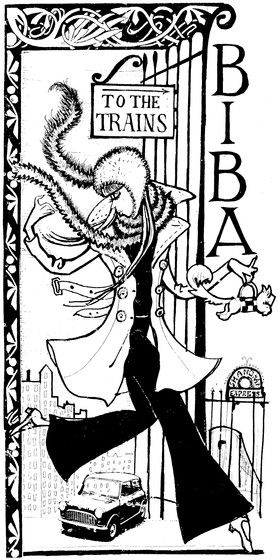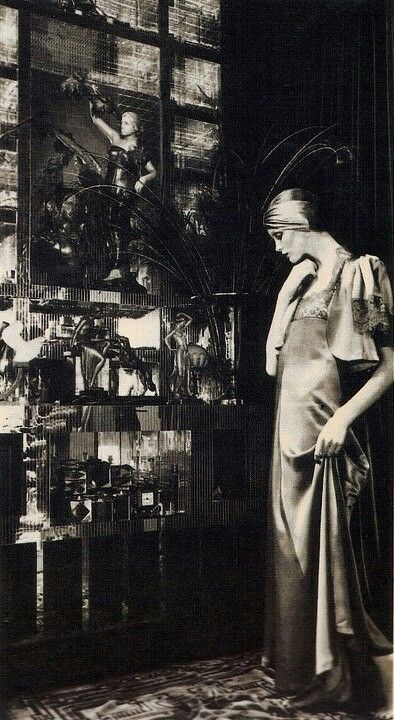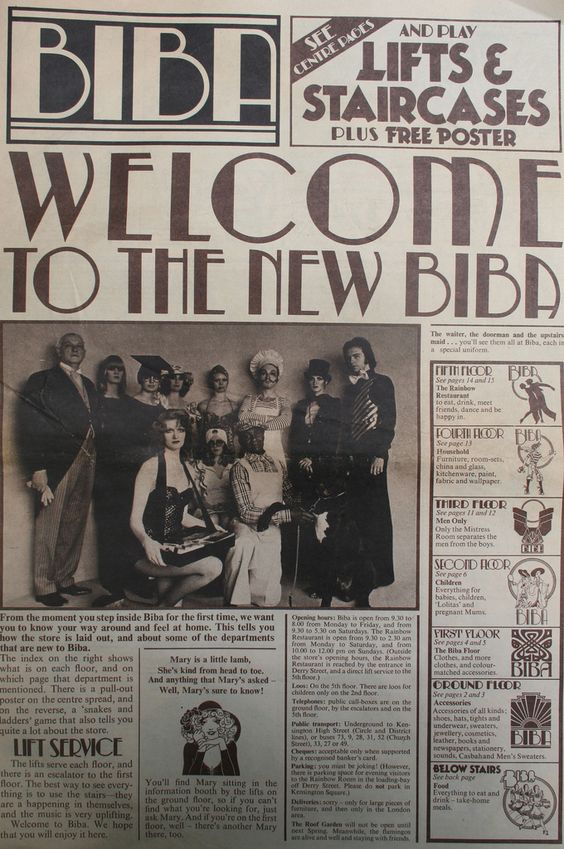
An illustration from Delisia Howard’s book, In Biba
How did you get involved with Biba and what were your main position(s) there?
I needed a job in Central London for the summer of 1968 (the year of Revolutions!) as I wanted to spend it with my new boyfriend Chris – we were at Hull University – so I responded to an advert in the Evening Standard for shop girls for BIBA, definitely the best shop in town. I was especially drawn to the “clothes allowance” they mentioned.
When I arrived there was a queue all round the block in Church Street (the 2nd Biba shop was across the road) so I joined at the end and began to wait. I was just about to give up and go home when a very exotic looking tall girl, Ann Behr, in charge of the workroom, swept down the line, picked me out and took me into Fitz’s (Barbara’s husband) leopardskin office for an interview. I think I must have looked quite interesting, as I got the job. After a couple of weeks it was discovered that I was a perfect size 10 for fittings – again I was just picked out. I didn’t volunteer as I thought I was only there temporarily and when I went over to the office I was kept on there as a buyer.
I used to come back from Hull at weekends to try on all the clothes, staying with Barbara. When I finished my course in 1969 Barbara offered me a job as cosmetics buyer and fittings model just as they were moving into the first High St. Kensington shop. I accepted and stayed until the end of the big store in 1975 (still trying on all the clothes!).
Apart from cosmetics and fittings I did many other jobs: press, household, accessories, etc. I was also the makeup artist for photoshoots until the wonderful Regis Huet arrived in the big store where he ran the beauty parlour.
Presumably, as the fit model you had a bird’s eye view on Barbara’s design process. Can you tell me about that?
Barbara’s design process – for clothes as for all the many other things produced – always started with a beautiful drawing. She sat in our open plan office drawing and drawing or would come in the morning laden with sheaves of them! For the clothes she passed the drawings to the workroom, often with copious notes, who did a “toile” (rough garment in muslin) which was tried on me and corrected by Barbara. It was then made up in fabric, which often had been specially printed for Biba in Biba colourways by girls who came in to paint them up. Again, when the sample came from the manufacturer, there were more fittings until it was right. Barbara was a perfectionist and didn’t scrimp on time or fabric in spite of the low prices.
Are there any memories of your time that stand out to you?
Memories that stand out? There are so many! Here are a very few…
The IMPACT of walking into the Church Street shop for the first time. It was dark, glittering, mysterious, like a wonderful Souk, with an intricate dressing table for trying on jewelry, great music, and sofas in the window where people lounged. Everything was SO CHEAP. There were no “assistants” asking you if they could help, or “security” men keeping an eye on you… heaven! (There was a similar amazement and love for the three subsequent shops, but as I was involved in the creation period, it was a more gradual process).
The office was full of young girls, Barbara among us, working away to get everything made. There was a huge bottle of Guerlain’s Mitsouko in an alcove and lots of laughing. When we went out into reception to see salesmen from various companies for the first time, they tended to look past us to see the real buyer. We saw virtually everything that people brought to us though Barbara had the final say. There was absolutely no time wasting in the way of “meetings” but time wasting having fun was OK. Everything came from Barbara, with input from all sides, and she took responsibility for everything.
Buying trips abroad were really hard work but always with Barbara (and often Fitz) in great hotels with very, very luxurious and loud meals, especially when they were researching at the same time for the restaurant in the Rainbow Room (I’ve never got out of the habit of trying everybody else’s food, and trying to see into the kitchen!)
Going in with great trepidation to make up the New York Dolls for their gig and finding them absolutely delightful.

A promotional shot in the Kensington High St. Biba store.
How did you see the Biba designs affecting the culture at the time? In my mind it has a symbiosis with the music scene at the time, considering that so many musicians shopped there. Do you think that visual musicians like Bowie and T.Rex were directly influenced by Biba?
I think Biba designs inevitably affected the culture at the time, especially regarding the music scene. In the big store extravagance abounded. Barbara encouraged experimentation and it became normal to dress in extreme styles. This even continued in the Punk era, after Biba ended.
I believe I saw that you were involved in designing the cosmetics range. What was your vision for the range and how it coordinated with the multitude of other Biba products. For instance, did you factor in, say, the current line of homeware and clothing lines in when choosing the color range?
I wasn’t really involved in designing the cosmetics range, Barbara came up with the revolutionary colours (I particularly appreciated the yellow based foundation, before it had only been pink!) She always saw colour as itself and in relation to everything else, but with the cosmetics she was even more discerning and playful.
She was inspired by Hollywood film makeup, to build up a huge range of colours and NOT to delete them with the seasons. It was all her ideas – brilliant. We also had a VERY ethical manufacturer (the company who manufactured Beauty Without Cruelty) and almost “home made” purity.
The only thing I did apart from getting it all together was to find the containers. We couldn’t get them made, especially initially as we didn’t have the large quantity required, so I got medical and scientific bottles, which were also very pretty.
I also read that you had a hand in designing the rooftop gardens, can you tell me a bit about that?
When Biba moved into the big store and inherited the roof garden we had just bought a little cottage in the east end, with a garden, and I was obsessed with it. I used to bring in plants to show Barbara! As with the cosmetics (and everything else!) it was Barbara who designed the garden, making everything more opulent and beautiful. Probably the best its ever been, before or since. It had great floats of creamy plants by the canals in the Spanish garden and black and white irises underneath.
I did give practical expertise; there was a gardening club in the evenings when we did all the planting – dressed in Biba of course! I remember getting up with very muddy hands to be introduced to Tony Curtis, who shook them without a flicker.
How did those years influence your post-Biba life?
Working for those years at Biba was revolutionary to my life. It was a combination of hard work (I sometimes felt frighteningly ill-equipped to do my job) and great fun. Barbara and Fitz were wonderful. They allowed and wanted you to contribute in every way. I learned so much – I didn’t realize fully how much until later. I’m so glad that Barbara is still around (though I miss Fitz) beautifying everything in her extraordinary way and that I’m still in touch with her. We still laugh a lot.
Thanks Delisia!

The Biba staff, including Delisia, on the cover of the Big Biba newsletter.
